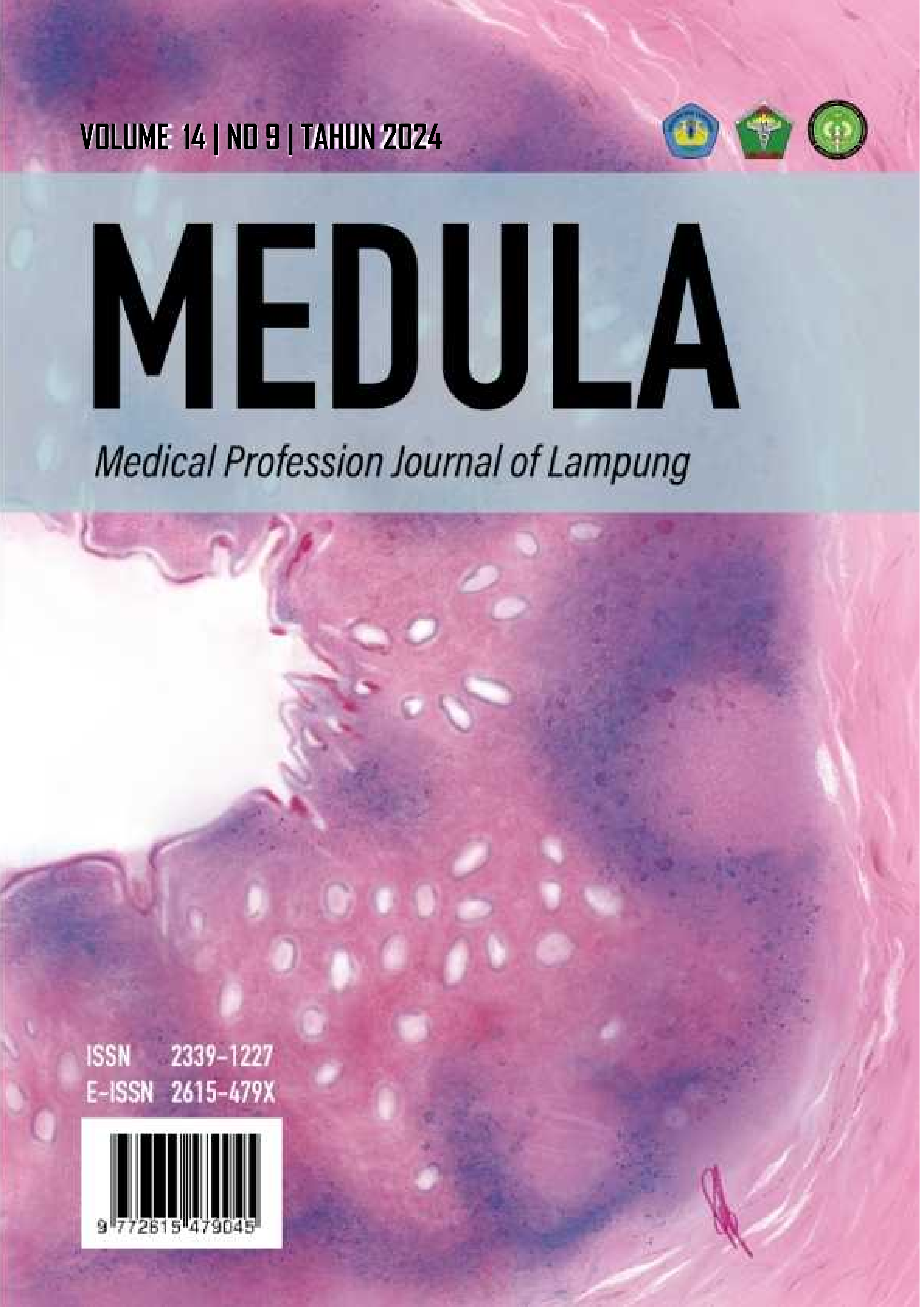Clinical Manifestation of Intenstinal Parasitic Infection in Children: Literature Review
DOI:
https://doi.org/10.53089/medula.v14i9.1394Abstract
Intestinal parasitic infection is a disease that still neglated, more likely found in developing countries. This infection is caused by a group of intestinal protozoa and worms, generally intestinal nematodes. In children, the STH group is the most common cause of infection. Infection often occurs via the fecal-oral route. Children more often consume infective stages to other age groups due to their poor hygiene behavior. Intestinal parasitic infections in children can cause high mortality and mobility. This infection causes a decline in health conditions, nutritional absorption, intelligence and productivity. This can simultaneously cause disruption of growth and development in children. These manifestations are related to the virulence of the parasite strain, the number of infective stages consumed, the age of the patient, and the state of the immune system at the time of infection. Apart from that, the manifestations that arise are widespread, asymptomatic to chronic. The manifestions are related to the digestive tract as the target organ of infections. However, manifestations can also be found outside the digestive tract. This is because organisms move to other organs through blood vessels. Manifestations that arise in the digestive tract are usually nausea, vomiting, abdominal pain, constipation, and diarrhea which is sometimes accompanied by blood. Not only that, weakness, fatigue, lethargy, and eating disorders are the manifestation of these infections. This is what causes growth and development disorders in children. Meanwhile, the extraintestinal mainifestations are liver abscess due to amoeba infection, Loeffler syndrome due to Ascaris lumbricoides infection and other manifestations. Usually, the intestinal nematoda infections caused have their own characteristics.
References
Athiyyah AF, Surono IS, Ranuh RG, Darma A, Basuki S, Rossyanti L, et al. Mono-parasitic and poly-parasitic intestinal infections among children aged 36 – 45 months in east nusa tenggara , Indonesia. Trop Med Infect Dis. 2023;8(45).
Renaldy RBY, Aflahudi MAN, Salma Z, Sumaryono, Fitriah MY, Sulistyawati SW, et al. Intestinal parasitic infection, the use of latrine, and clean water source in elementary school children at coastal and non-coastal areas, Sumenep District, Indonesia. Indones J Trop Infect Dis. 2021;9(1):16–23.
Winerungan CC, Sorisi AMH, Wahongan GJP. Infeksi parasit usus pada penduduk di sekitar Tempat Pembuangan Akhir Sumompo Kota Manado. J Biomedik Jbm. 2020;12(1):61–7.
Charisma AM, Fernita NF. Prevalensi protozoa usus dengan gambaran kebersihan personal pada anak SD di Ngingas Barat. J Anal Kesehat. 2020;9(2):67–71.
Siahaan L, Panggabean YC, Sinambela AH, Sinaga J, Napitupulu J. Infeksi parasit usus di daerah Kumuh: Suatu infeksi yang terabaikan. J Formil (Forum Ilmiah) KesMas Respati. 2023;8(3):281–91.
Soedarto. Buku Ajar Parasitologi Kedokteran. 2nd ed. Jakarta: Sagung Seto; 2016.
Anggraini DA, Fahmi NF, Solihah R, Abror Y. Identifikasi telur nematoda usus Soil Transmitted Helminths (STH) pada kuku jari tangan pekerja tempat penitipan hewan metode pengapungan (Flotasi) menggunakan NaCl. J Ilmu Kesehat Bhakti Husada Heal Sci J. 2020;11(2):121–36.
Belkessa S, Ait-Salem E, Laatamna AE, Houali K, Sönksen UW, Hakem A, et al. Prevalence and clinical manifestations of Giardia intestinalis and other intestinal parasites in children and adults in Algeria. Am J Trop Med Hyg. 2021;104(3):910–6.
Pyzocha N, Cuda A. Common intestinal parasites. Am Fam Physician. 2023 Nov;108(5):487–93.
Visvesvara GS. Giardiasis: an overview. IMJ Ill Med J. 1983;164(1):34–9.
Ahmed M. Intestinal parasitic infections in 2023. Gastroenterol Res. 2023;16(3):127–40.
Ünal E, Arslan S, Onur MR, Akpinar E. Parasitic diseases as a cause of acute abdominal pain: imaging findings. Insights Imaging. 2020;11(1).
Nasrallah J, Akhoundi M, Haouchine D, Marteau A, Mantelet S, Wind P, et al. Updates on the worldwide burden of amoebiasis: A case series and literature review. J Infect Public Health. 2022;15(10):1134–41.
Lebu S, Kibone W, Muoghalu CC, Ochaya S, Salzberg A, Bongomin F, et al. Soil-transmitted helminths: A critical review of the impact of co-infections and implications for control and elimination. PLoS Negl Trop Dis. 2023;17(8 August):1–21.
Jourdan PM, Lamberton PHL, Fenwick A, Addiss DG. Soil-transmitted helminth infections. Lancet. 2018;391(10117):252–65.
Lydia Lestari D. Infeksi Soil Transmitted Helminths pada Anak. Sci J. 2022;1(6):423–33.
Hadidjaja P, Margono S s. Dasar Parasitologi Klinik. 1st Ed. Jakarta: Badan Penerbit Fakultas Kedokteran Univeritas Indonesia; 2011.
Staf Pengajar Departemen Parasitologi, FKUI. Buku Ajar Parasitologi Kedokteran. 4th ed. Jakarta: Badan Penerbit Fakultas Kedokteran Univeritas Indonesia; 2017.
Burke JA. Strongyloidiasis in Childhood. Am J Dis Chiild. 1978;132.
Downloads
Published
How to Cite
Issue
Section
License
Copyright (c) 2025 Medical Profession Journal of Lampung

This work is licensed under a Creative Commons Attribution-ShareAlike 4.0 International License.














